- Home
- Encyclopedia
- John B. Kendrick: Cowboy, Cattle King, Governor...
John B. Kendrick: Cowboy, Cattle King, Governor and U.S. Senator
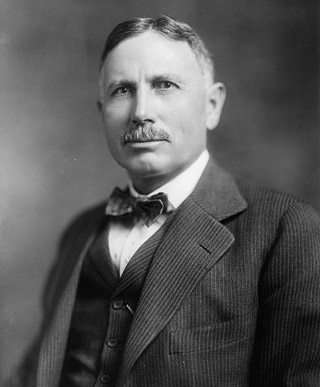
John Benjamin Kendrick, one of the most remarkable politicians Wyoming has seen, rose from poverty to great wealth and later to the pinnacle of political power.
Early life
Born in Cherokee County, Texas, in 1857, he was orphaned at an early age. His father, Georgia-born cotton farmer John Harvey Kendrick, drowned in 1860 while attempting to ford a river. John Harvey’s widow, Irish immigrant Anna Maye Kendrick, died of fever three years later, leaving two children to fend for themselves. Though John Harvey had left behind a considerable estate, it was lost during the family’s backing of the Confederate cause during the Civil War.
For years, John B. and his younger sister, Rosa, were shuttled back and forth among aunts, uncles and a variety of older half-brothers and sisters. Some were distantly affectionate, others downright brutal in their treatment of the two orphans. During these years Kendrick attended school sporadically, finally finishing for good around the fifth or sixth grade. Any education he needed thereafter he obtained on his own, usually around a campfire.
Kendrick rarely spoke of his early childhood, preferring to begin his personal anecdotes around the time he first went out on his own as a fledgling cowboy. One of his first jobs was breaking horses for room and board. The turning point in his life came in 1879, at the age of twenty-two, when he signed on with the Snyder-Wulfjen Brothers of Round Rock, Tex., to help bring a herd of steers from Matagorda Bay on the Gulf of Mexico to the grasslands of Wyoming.
The trail from Texas
Kendrick nearly died of stomach inflammation before he ever got out of Texas. Through the ministrations of the camp cook, he survived and rode the dusty end of the herd through Oklahoma’s Indian Territory, past the wild life of Dodge City, Kan., across the North Platte River in Nebraska, and into the open ranges of eastern Wyoming Territory. In 1916, Kendrick recalled that the trip took five months, from early April to the end of August. Moving three thousand head of rangy cattle, they averaged about eighteen miles a day:
We never saw a single habitation of man from a point in Texas, fifty miles south of Red River, until we reached Dodge, Kansas, a distance of 400 miles. I do not remember coming in contact with or seeing a wire fence between Fort Worth, Texas, and the head of the Running Water in Wyoming.
In 1884, Kendrick made another trip to Wyoming, this time as foreman of an outfit owned by the Wulfjen brothers. This second trip was just as difficult, yet just as fascinating:
After a hard night’s work, with stampeding cattle and the elements, every man would swear that that trip would be his last, but I never knew a man to give up his work on the Trail because of its physical hardships, and I knew men at that time who had been over the Trail eight or ten times. … The element of danger that was a part of almost every day’s experience did not detract from the fascination of the trip.
Ranching in Wyoming
Kendrick’s first Wyoming home was on the Charles Wulfjen ranch north of Cheyenne; soon he became foreman of the outfit. Later, he relocated to a ranch near Lusk, where he eventually hired on as foreman of the Converse Cattle Company, a large cattle operation running out of east-central Wyoming.
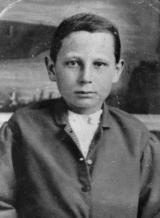
In 1886-87, a disastrous winter brought financial ruin to most of Wyoming’s livestock industry. Cattle and sheep died by the thousands, and bankruptcy claimed dozens, if not hundreds, of victims. One of these was the Converse Cattle Company.
The absentee owners – non-ranching businessmen from Chicago, Milwaukee and Omaha – hired Kendrick to take over operation of the main ranch, known as the OW, on Old Woman Creek north of Lusk. Despite his inexperience as a manager, Kendrick made a success of the OW, returning profits to the owners on an annual basis despite weakened herds and an overgrazed countryside. During this time he invested most of his wages in cattle, which he convinced his employers to let him keep, despite the fact that on Wyoming ranges at least, (most ranchers frowned on cowboys owning personal herds.
In 1889, Kendrick moved the entire OW operation – cattle, horses and cowboys – to the Hanging Woman Creek drainage in southeastern Montana’s Big Horn County. Here he found plenty of water, forage and room for expansion.
In January 1897, after much debate with the absentee owners, Kendrick purchased majority ownership of the Converse Cattle Company – including the OW – for the relatively low price of $38,000. The purchase price included all the company’s cattle at seventeen dollars a head (calves thrown in for free), 213 head of horses, plus a seventy-five percent interest in the ranch and all of its equipment.
The Kendrick Cattle Company
This became the basis for the Kendrick Cattle Company, which eventually encompassed more than 210,000 acres of deeded and leased land in southern Montana and northeastern Wyoming.
Shortly after moving the herds to Montana, Kendrick became reacquainted with a young woman he had known for ten years. Eula Wulfjen (1872-1961) was the teenaged daughter of Charles Wulfjen, who had hired Kendrick for his first cattle drive back in 1879. Educated at finishing schools in Colorado and Texas, and known as an accomplished musician and artist, Eula was no delicate city girl. She had spent most of her childhood on the Mule Shoe ranch north of Cheyenne, where she learned to ride before she even learned to walk.
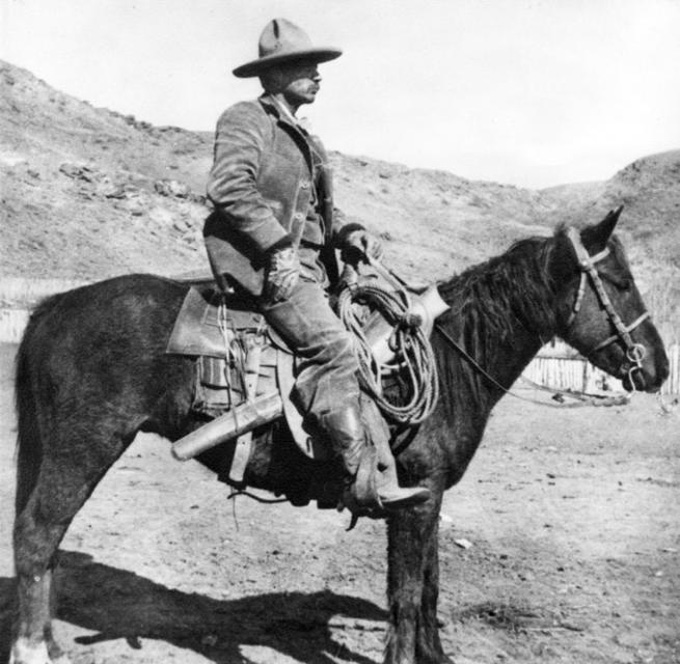
Eula Kendrick
As reported by Frances Parkinson Keyes in Delineator Magazine, John and Eula first met when she was only seven years old. She grew very fond of him as a child, and would tell people she planned to marry him when she grew up. But when she was seventeen, Keyes wrote, Eula “began to realize she had ceased to think of him as merely a friend of her father’s and to consider that her childish remarks about marrying him when she grew up had perhaps been prophetic.” The couple married in Greeley, Colorado, and moved to the OW following an extended honeymoon through the eastern United States.
Wealth – and politics
Kendrick’s political aspirations, meanwhile, had begun both early and unsuccessfully. In 1882, he suffered a crushing defeat in the Lance Creek constable election, receiving only three of a possible twenty-two votes. In 1890, he was offered the opportunity to serve in Wyoming’s Territorial legislature, but he declined, preferring to keep his focus on ranching.
For the next twenty years he concentrated on building his financial base and cultivating powerful connections throughout the state. During those years he served as president of the First National Bank in Sheridan, and vice president and president of the influential Wyoming Stock Growers Association.
Finally, in 1910, when he was already well known around the state, Kendrick was elected to the State Senate from Sheridan County. In 1912, the Republican presidential vote split bitterly between incumbent Howard Taft and Theodore Roosevelt, trying for a third term as president under the new Bull Moose or Progressive party. The result was the election of the Democrat, Woodrow Wilson.
Also that year, state legislatures elected U.S. senators for the last time. In Wyoming, Democrats nominated Kendrick. Like the nation as a whole, the Wyoming Legislature was bitterly divided, and Kendrick lost his senate bid to Francis E. Warren, the longstanding Republican incumbent. In 1914 Kendrick ran for governor, however, and defeated Republican Hilliard S. Ridgeley, a Cheyenne lawyer, in a relatively civil campaign.
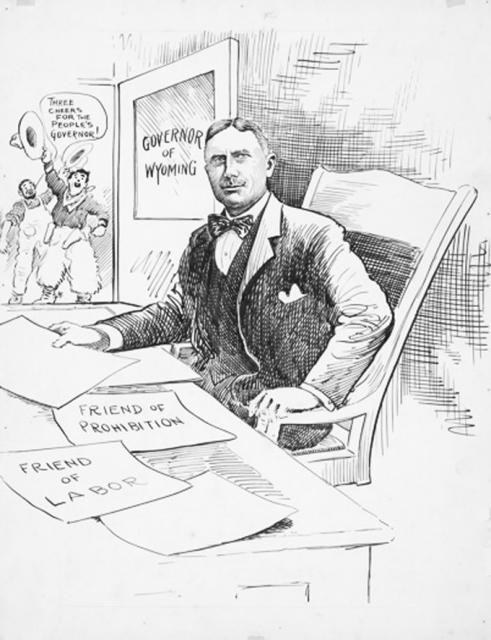
Governor Kendrick
In state politics he advanced many of the Progressive causes of the time. As a state senator, he had helped secure the passage of Wyoming’s first game laws; as governor, he enforced them. As governor, Kendrick and the Legislature in 1915 established a state workmen’s compensation system, a public utilities commission, passed a constitutional amendment allowing for lending of public money to farmers, and worked to extend women’s rights, among other issues.
Senator Kendrick
In 1916, after only two years as governor, people began pressuring him to run again for the U.S. Senate. He defeated the incumbent Clarence D. Clark by a comfortable 3,000 votes – and that was despite his opponent’s charges of corruption for having bought nearly 10,000 well-watered acres of state lands while he was governor and thus president of the state land board. These charges were true, and Kendrick had acted in violation of state law. But he proved too popular, in a year when Democrats also were sweeping the national elections, to be harmed by the negative publicity.
Years later, he recalled that he initially resisted the pressure to run. But, he added, “[m]y name was written in the ballots and I was elected to the Senate. From this you will see that I ‘became interested in the Senate’ rather involuntarily and was really drafted into service!”
Though he often missed roll-call votes, rarely spoke on the Senate floor, and studiously avoided any appearance of statesmanship, he worked tirelessly on behalf of his favorite projects: those dealing with irrigation, land use, and protection of the nation’s natural resources. During his seventeen years in the Senate, Kendrick served as chairman of the Committee on Public Lands and was a member of the Senate Committee on Agriculture and Forestry and the Committee on Irrigation and Reclamation.
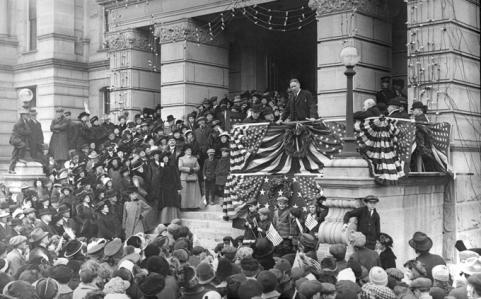
Because he was successful in getting bills passed that benefited his ranching and farming constituents, he remained enormously popular in Wyoming and was re-elected to the Senate two more times, in 1922 and 1928.
Throughout his career, Kendrick downplayed his own importance and abilities. He liked to tell humorous, self-deprecating stories, and had no illusions about his abilities as a public speaker. “I’ve never qualified as an orator,” he told Washington Herald reporter Fraser Edwards in 1929, “but I’ve gotten so that I can speak anywhere on any subject except in the United States Senate, and nobody there ever listens to what you have to say.”
While his fellow senators may not have listened, the press was almost always tuned in. During Kendrick’s long political career, scarcely a Wyoming newspaper was published that did not include a story, editorial, quote or cartoon about him. He was constantly accused, defended, praised and lampooned by both large and small publications.
Early in his career, in an effort to protect his interests and those of the Democratic Party, Kendrick purchased controlling interest in two influential newspapers, the Sheridan Enterprise and the Cheyenne State Leader. Such connections allowed him and his party to balance the harsh coverage of the state’s leading Republican papers, including the Sheridan Post and the Cheyenne Tribune.
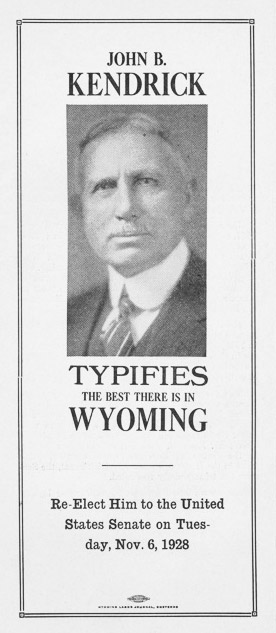
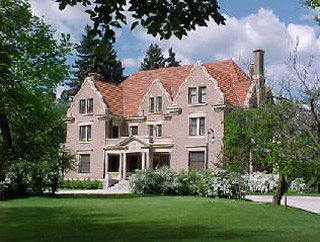
|
In newspapers both in and out of state, Kendrick was frequently criticized for his liberal leanings. In 1922, the Douglas Enterprise wryly commented on the irony of Kendrick’s popularity with liberal reformers:
It is extremely mirth-provoking to think of the resounding, bombastic oratory and silly chatter of the would be saviors of the country, who lambasted all corporations and rich men (excuse us, republicans only) at the Democratic-Progressive-Nonpartisan-IWW convention which met here last week, and then have them wind up by endorsing Millionaire John Kendrick, the wealthiest man in the state.
No matter what the newspapers said about him, Kendrick remained unbeatable. It was suggested that in the election of 1934, he be nominated by both the Republican and Democratic parties and then unanimously acclaimed senator. His name was even bandied about in connection with the White House. Even so, Kendrick stated that he planned to retire at the end of his third term, in 1934. At age seventy-six, he was the oldest serving man in the Senate. He wanted to return to his Sheridan home, Trail End, to enjoy his grandchildren and relax during his remaining years.
The Kendrick legacy
By the fall of 1933, friends and family began to notice that Kendrick looked exhausted. He was encouraged to take time off and relax, but he did not. On the evening of November 1, he collapsed in his downtown Sheridan office, complaining of a severe headache. He slipped into a coma and died two days later, surrounded by his immediate family. A cerebral hemorrhage was listed as the cause of death. He was buried in Sheridan’s Mount Hope Cemetery.
John Kendrick’s legacy to Wyoming is considerable. Not only did he help uncover the illegal leasing of the state’s oil reserves at the time of the Teapot Dome scandal in the early 1920s, he helped to establish compensation laws to benefit injured workers. He worked to bring an end to the meatpacking monopoly that was strangling American farmers and consumers alike. He was influential in movements to protect such landmarks as Yellowstone and the Tetons. And he worked to bring water to the state’s farmers through the Alcova, Seminoe and Pathfinder projects. The federal Kendrick Project, bringing water to farmers along the North Platte River below Alcova Dam, bears his name.
He also established a firm example of long-term success as a Democratic politician in a Republican state. He did it with his humorous charm, thick skin, broad intelligence, and cheerful willingness to collaborate with political opponents. Other Democrats down the decades made use of similar qualities, most recently governors Dave Freudenthal, Mike Sullivan, and Ed Herschler, and U.S. Rep. Teno Roncalio.
Through sheer determination, he worked himself out of the rut of poverty and into a position of wealth and influence. Far from perfect, John Benjamin Kendrick should nevertheless be celebrated as one of Wyoming’s political greats, serving as an inspiration to those who start out with nothing yet hope some day to attain greatness. John Kendrick is proof that leaders are not born; they make themselves.
Resources
Primary Sources
- “A Story of Human Interest: John B. Kendrick,” Cheyenne State Leader, 16 October 1912.
- Cutting, Malcolm C. “The Northwest Trail to the Senate,” The Country Gentleman, March 1926.
- Deming, William C. “Stirring Incidents in Life of U. S. Senator Kendrick,” Wyoming State Tribune, 28 August 1932.
- Edwards, Fraser. “Kendrick of Wyoming, Senate’s Cattle King,” Washington Herald, 2 September 1929.
- Gilbert, Clinton W. “The Sagebrush Senator,” Collier’s, 30 June 1928.
- Kendrick, John B. “Reclamation,” speech delivered at the Secretary of the Interior’s Conference on Reclamation 15 December 1925. Congressional Record, 6 January 1926.
- __________. “The Texas Trail,” Wyoming Tribune, 16 September 1916.
- __________. “The Unromantic West,” The Country Gentleman, 1924.
- Kendrick, Rosa-Maye. “Fragments of My Trip with Daddy,” unpublished manuscript, September 1926. Kendrick Family Research Files, Trail End State Historic Site.
- Keyes, Frances Parkinson. “Over the Trail to the Senate,” Delineator Magazine, April 1931.
- Knappen, Theodore M. “The West at Washington: Significant News from the Nation’s Capital,” Sunset Magazine, June 1924.
- Memorial Services Held in the House of Representatives of the United States, Together with Remarks Presented in Eulogy of John B. Kendrick, Last a Senator from Wyoming. Washington: Government Printing Office, 1934.
- Standish, John K. “Senator John B. Kendrick Came Up the Texas Trail With a Herd of Dogies During Hectic Range Dies,” Lusk Herald, 28 May 1936.
- Wing, Andrew S. “John B. Kendrick, The Orphan Who Took the Texas Trail to a 200,000 Acre Ranch and the U. S. Senate,” Farm and Fireside, November 1927.
Secondary Sources
- Burroughs, John Rolfe. Guardian of the Grasslands: The First Hundred Years of the Wyoming Stock Growers Association. Cheyenne: Pioneer Printing, 1971.
- Carpenter, Mary. “History of Old Livestock Brands Traced to Beginning,” reprinted in an unidentified newspaper, March 18, 1935. Trail End Historic Site collections.
- Carroll, Eugene. “John B. Kendrick, Cowpoke to Senator, 1879-1917,” Annals of Wyoming, Spring 1982.
- __________. “John Benjamin Kendrick, Western Senator,” master’s thesis, University of Wyoming, 1977.
- Fley, Joann. “John B. Kendrick’s Career in the United States Senate,” master’s thesis, University of Wyoming, 1953.
- Georgen, Cynde A. One Cowboy’s Dream: John B. Kendrick, His Family, Home & Ranching Empire. Virginia Beach, Virginia: Donning Company Publishers, 2004.
- Henderson, Harry B., Sr. “Governors of the State of Wyoming: John B. Kendrick,” Annals of Wyoming, 1943.
- King, Bucky. The Empire Builders: The Development of the Kendrick Cattle Company, Sheridan, Wyoming: By the Author, 1992.
- Larson, T .A. A History of Wyoming, Lincoln: University of Nebraska Press, 1965, 194, 326-329, 334, 388-395, 403, 404, 408-409, 418-419, 421-423, 426-427, 429, 432, 437, 441, 448-450, 455.
- Lewellyn, Michael M. “John Kendrick and the Revival of the Democratic Party in Wyoming, 1910-1914,” master’s thesis, University of Wyoming, 1975.
For Further Reading
- For more on the cowboy life when open-range ranching was at its peak, read OW Ranch foreman Addison Spaugh’s description of the 1884 spring roundup on Lance Creek in eastern Wyoming Territory, when 20 different cattle outfits represented by nearly 200 men with 2,000 horses rounded up and worked 400,000 cattle over the course of six weeks. John B. Kendrick was there as well.
Illustrations
- The undated portrait of John B. Kendrick, by photographers Harris and Ewing, is in the collections of the Library of Congress, and was apparently taken while he was serving as governor.
- The photos of Kendrick as a boy, and on horseback on the OW Ranch, are both from the Manville Kendrick Collection at the Trail End State Historic Site in Sheridan. The photo of Kendrick giving his inaugural address is from the Eula Harmon Hoff Collection at the Trail End State Historic Site. All three are used with permission and thanks. The photo of the mansion is from the historic site’s website.
- The political cartoon from John B. Kendrick’s 1914 race for governor, and the flyer from his 1928 campaign for re-election to the U.S. Senate are from the American Heritage Center at the University of Wyoming. Used with permission and thanks.
